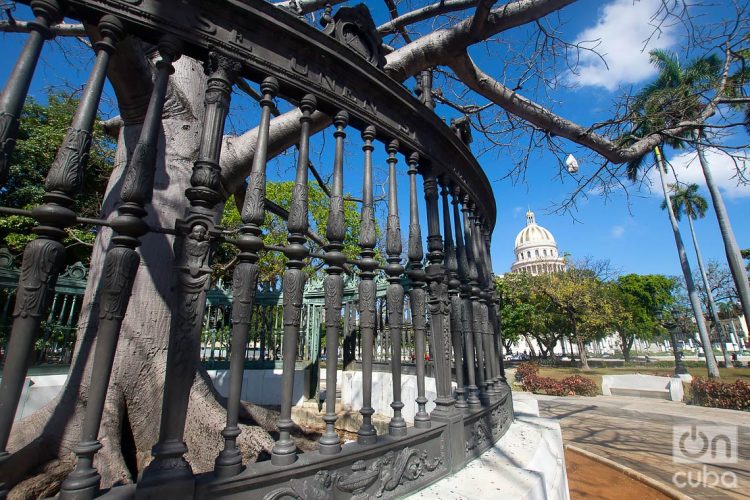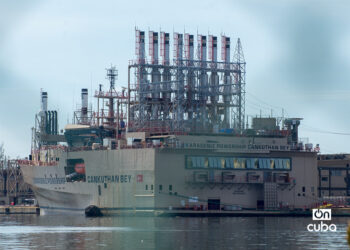The daily and cosmopolitan life of Havana has one of its most representative places in the Parque de la Fraternidad. This vast esplanade, with its trees, benches, and monuments, is one of the Cuban capital’s points of greatest confluence, a place of passage and meeting, of rest and contemplation, and even of love dates and sexual skirmishes, although today the pandemic imposes an unusual landscape to its days and nights.
Its real name, shortened by popular usage and rationality, is Parque de la Fraternidad Americana, and long before it is what it is today, the lands it currently occupies were mangroves and groves, in a colonial Havana that grew to encounter it. At the end of the 18th century, it would become a field for military exercises that would improve in its layout and infrastructure, and as such, with the name of Campo de Marte, it would reach the Republic. Then it would renew its image again and almost hosted a zoo, but the devastating cyclone of 1926 would destroy it and change its future.

In a short time, it would recover from nature’s fury to emerge as the Parque de la Fraternidad. Its metamorphosis was catalyzed by the intense constructive movement promoted in its beginnings by the government of Gerardo Machado—the same one that would later try to perpetuate itself in power through blood and fire—and by the city’s celebration of the 6th Pan American Conference, which would serve as a reason for its new name and for the planting of the iconic ceiba tree that has crowned the place ever since.
Famous French urban planner Jean Claude Nicolas Forestier would be in charge of the design of the park, made up of several plots of different dimensions that play with the layout of the surrounding streets and sidewalks, and in which, together with benches, lampposts, and other ornamental elements, highlighted its meticulous gardening. The larger plot would then be planted with the ceiba tree, designated the “Tree of American Fraternity,” and which, according to some sources, was brought from the town of San Antonio de los Baños and, according to others, from the Cerro neighborhood.
In any case, when the ceiba tree was transplanted in the park on February 24, 1928—a tree in itself sacred in Cuba, particularly for the religions of African origin—it would be fertilized with soil from each of the American republics participating in the conference and surrounded by a railing in which the national shields were placed and words of José Martí belonging to his memorable essay “Our America” were inscribed. “The peoples,” it is written on it, “do not unite except with ties of friendship, brotherhood, and love.”
This is how the Parque de la Fraternidad Americana was born, which, in reality, according to Forestier’s design, is more than a single park, it is a group of several, located at the southern end of the no less known Paseo del Prado and in whose surroundings other important Havana arteries are located, such as Monte, Reina and Dragones, and also buildings and emblematic places of the city such as the monumental Capitol, the Aldama Palace, the Saratoga Hotel, the Central Computer Science Center, the India Fountain and the entrance to Chinatown. Over the years, busts of heroes and relevant figures of the continent such as Simón Bolívar, Benito Juárez, Abraham Lincoln, José de San Martín, and Toussaint Louverture would be placed on its grounds.
Life would, however, give it a less solemn, more worldly character. And there, where the colonial troops once paraded, where in 1856 Matías Pérez took off on his balloon and where the American republics sealed their brotherly commitment in iron and earth, the townspeople would end up imposing their walk, letting off steam and carrying out their routines. And the crowded bus stops, the hurried passersby, the lovers, the fortune-tellers, the street vendors, playing children, the tourists, the transvestites, the police would arrive. And the symbolic ceiba, now without the greenery of yesteryear, would also receive offerings and waste that those who planted it could never have imagined.
This is how it has survived until today, until the third decade of the 21st century, becoming a witness and, at the same time, a protagonist of the passage of time in Havana. It is no longer the Campo de Marte that it once was, nor the pristine and presumptuous park that the French urban planner envisioned, but it has not lost life, grace, or beauty, although the years have left its wounds and many Havanans today ignore its history and pass it with a hurried pace in the midst of the coronavirus pandemic.


































